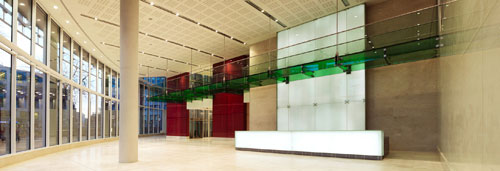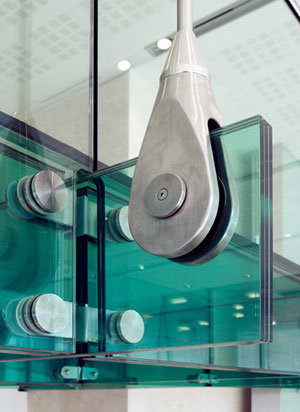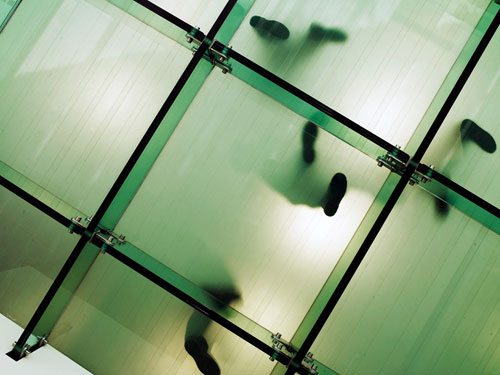Shattering Myths About Glass
Each of the three-story-high glass-and-cable facades incorporates a glass-canopied entrance. "What we tried to do is basically use these pieces that we need anyway and make sense of them structurally in a bit of an innovative way," explains Laufs. For example, the back wall of the vestibule, containing a second set of entry doors, acts like a column to hold up the vestibule roof. "We figured that if we have to have a second door situation for thermal reasons, let's use it structurally as well," says Laufs. Perhaps more interesting, the structural silicone-sealed vestibule roof glazing over the entrance doors uses the glass as shear bracing, acting like a horizontal intermediate truss to further reduce the effective span of the facade.
Only the horizontal glass of the vestibule roof is laminated for redundancy purposes because of its overhead position. According to Laufs, "If the glass would really fail badly, it would still stay in place."
The engineers used SJ Mepla, another finite element analysis program, for the calculations of the glass structure, but relied on the same tensegrity software used for the staircase design to determine the prestressing of the cables on the facade.
Just past the entrance doors of another building, in this case a new office building in London designed by Michael Aukett Architects, Malishev Wilson Engineers animated an otherwise ordinary lobby by suspending a glass walkway over the reception desk. "The architect thought that the entrance lobby needed some kind of special feature," recalls engineer Gennady Vasilchenko-Malishev. "The challenge was convincing a conservative client who was very mindful of the budget, without sacrificing the quality we were aiming for." (As a cost-cutting measure, the designers opted out of using low-iron, or completely transparent, glass - hence the greenish tint to the walkway.)
The walkway's floor panels are composed of three layers of 1â„2-inch-thick glass. The laminated panels rest on a series of glass beams. Primary beams, running along the width of the walkway, are spaced 5 feet apart, with every other one hung from the ceiling above by high-strength stainless-steel rods. (The structure is not completely suspended; one end of the walkway is connected to a wall.) Two secondary beams run along the length of the walkway.
 |
A glass walkway animates an otherwise ordinary lobby inside a London office building. Photo: Mel Yates |
Â
 |
Hung from above, a steel fork slots over the glass beams beneath the walkway�s floor panels. Tensile stresses are high around the holes in the glass. Photo: Mel Yates |
"The splice detail between the primary and secondary beams looks fairly simple, but because glass is obviously a very tight-tolerance material, fitting all this together was really quite complex," says Malishev. The glass works in both compression and tension. The stainless-steel forks that are fixed to the ends of the beams to hang the walkway create high-tensile stresses around the holes in the glass. While the fork slots over the beam, a pin passes through the fork so that the whole weight is transferred through the hole in the glass. A high-strength, epoxy-resin-based mortar completely fills the hole to ensure a good load transfer between the different plies of the glass.
"The real improvement over the last decade is in the detailing," Malishev notes. "When we carried out tests on earlier projects, we found that the load share was uneven. A full-scale mock-up test of this project revealed that the load transfer between the laminates was very even. That means we've achieved a detail with greater reliability."
The mock-up was built not necessarily to test the glass, but to prove to the client beyond a doubt that structural glass is safe. "We re-created an extreme situation where we broke some of the glass and loaded it to full capacity to show that the walkway would still work in a fail-safe environment," Malishev explains. The mock-up also revealed to the engineers that they needed to increase some of their tolerances. "When we were assembling the mock-up, we realized that some of our tolerances were too tight, and the builder couldn't successfully put it together without too much trouble."
The walkway was a joint venture with U.K.-based F.A. Firman, a pioneering glass manufacturer that worked on such early structural-glass projects as Rafael Viñoly's Tokyo International Forum, completed in 1996.

|
Â
A combination of forward-thinking designers and clients who weren't afraid to push boundaries was needed to get those early projects built. "When we did our first glass staircase for a shop in London in 1985, no one had ever done one before," Macfarlane recalls. "But once it's there, and you can walk on it and see that it's safe, you get confidence to do the next thing. We're working in an architectural domain where there is much more to think about than limited levels of performance. Each job requires a custom solution. We keep starting from a blank page."
 |
Without the use of highly transparent low-iron, or white, glass, the walkway has a greenish tint. Photo: Mel Yates |








